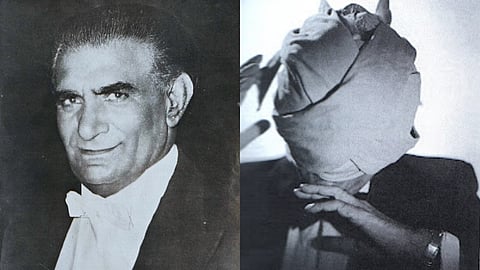
- HOMEGROWN WORLD
- #HGCREATORS
- #HGEXPLORE
- #HGVOICES
- #HGSHOP
- CAREERS
- ABOUT US
- CONTACT US

In 2023, filmmaker Wes Anderson, known for his whimsical, storybook-like narratives, symmetrical compositions, pastel colour palettes, and precise, almost theatrical staging released a collection of short films based on the beloved stories of Roald Dahl. Among them, was 'The Wonderful Story of Henry Sugar', a short film that follows a wealthy man who learns a yogic technique to see without using his eyes, and then uses this extraordinary skill to win at gambling.
In the film, Sir Ben Kingsley plays a mysterious figure who first masters the art of "seeing without seeing"; an enigmatic performer who can read books, navigate rooms, and complete complex tasks while blindfolded. But what many viewers might not realize is that Kingsley's character is based on a real-life magician — Kuda Bux, a man whose astonishing 'X-ray vision' act once captivated audiences around the world.
Born in 1905 in the town of Akhnoor in Kashmir, Khuda Bux — originally Khudah Baksh — grew up in a world that viewed magic and mysticism as part of the everyday fabric of life. But even in that context, he was extraordinary. As a young man, he travelled extensively through India, absorbing techniques from yogis in Haridwar. It was there, among sages and seekers, that he honed the abilities that would one day capture the Western imagination.
Bukhsh’s journey from Kashmir to global fame took place at a time when the Western gaze often saw India through a lens of exoticism — a land of snake charmers and rope tricks. Yet, Bukhsh was different. His talents defied simple explanations or easy categorization. While stories of fakirs and mystics were often met with polite curiosity, Bux’s acts demanded serious attention.
In 1938, standing at the Rockefeller Center in Manhattan, he made history. Invited by Robert Ripley for his Believe It or Not! radio show, he performed a fire-walk that left the audience spellbound. Two pits of flame roared as Bukhsh, clad in a turban, briskly walked across them — not once, but twice. Doctors examined his feet immediately after. Apart from a single small burn where a coal had stuck, his feet were unharmed. Even TIME magazine, astonished, chronicled the event, noting the physicians’ marvel.
But it was not just fire-walking that earned him fame. Khudah Bukhsh was best known for what newspapers breathlessly described as "X-ray vision". Before skeptical audiences, that often included doctors, scientists, and journalists, Bux would have his eyes sealed shut. Dough would be pressed into his eye sockets along with layers of cotton and surgical tape was wound around his head with a heavy blindfold tied over it all. Still, he would perform miracles: reading passages from books, navigating obstacle-laden rooms, even riding a bicycle through the crowded streets of London without faltering.
As a teenager, he claimed to have been taught a yogic exercise by a mystic, involving deep concentration on the black center of a candle flame. Night after night, he would practice until he could conjure up vivid mental images, even of his brother's face, with his eyes closed. Over time, Bux believed he had cultivated an "inner sense of sight", a kind of mental vision that allowed him to perceive objects without the use of his eyes.
By his mid-twenties, he said he could faintly outline objects by concentrating, and by age 28, according to the BBC, he was able to read entire books while blindfolded. His performances would later expand to feats like reading foreign languages off a blackboard, tracing patterns with uncanny precision, and navigating obstacle courses, all while appearing completely sightless.
Although many marveled at Kuda Bux’s supposed supernatural abilities, claims soon surfaced that his X-ray vision was the result of well-practiced techniques rather than any real paranormal power. Investigators suggested that he peeked subtly down the sides of his nose, arranged objects in strategic positions to make navigation easier, and relied heavily on distraction and theatricality to sell the illusion. Yet, despite these explanations, Bux’s popularity hardly waned. His audiences were less concerned with the mechanics behind the performance and more enchanted by the spectacle itself.
Ever the showman, Bux understood the power of spectacle. His demonstrations were not just stunts but invitations — to wonder, to doubt, and even to believe. They challenged deeply held beliefs about perception, consciousness, and the boundaries of human ability. And he did it all with a knowing grace, meeting accusations with a smile and welcoming doubt as part of the magic. His abilities were less about individual stardom and more about a timeless fascination with the notion that there are still mysteries within the human body and mind that we barely understand.
